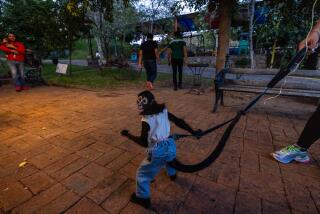Peace Proves Deadly for Vietnam Animals
If half a century of war was destructive to the wild animals of Vietnam, two decades of peace are proving even worse.
The Indochina tiger, which once roamed the countryside fearlessly, is rarely seen. Elephants, bears, peacocks, the clouded leopard, deer, monkeys and other native wildlife are disappearing because of rampant poaching and large-scale destruction of their forest habitat. Even the deadly cobra is in full retreat.
At greatest risk are certain kinds of sprightly colored monkeys called langurs that exist in the wild only in Vietnam and now are on the verge of extinction.
But a collection of American and German zoos and the American branch of the Swiss-based World Wildlife Fund are working with the Vietnamese to save the langurs and other imperiled species.
“You have wildlife that somehow managed to survive 50 years of warfare but may not survive the next 15 to 20 years of economic growth,” said Karen Killmar, associate curator of mammals at the San Diego Zoo.
“In many ways, Vietnam was closed to outside ideas for many years and missed the entire environmental movement,” said World Wildlife Fund official David Hulse in Hanoi.
In an attempt to prime its struggling economy, the Communist government of Vietnam is cutting down forests to provide acreage for farming or manufacturing. With a population of 75 million and an annual growth rate of 2%, Vietnam is one of the densest and fastest-growing nations in Asia.
Up to half of the forests were damaged or destroyed by the long war. The Vietnam News Agency estimates that with several hundred thousand acres being cleared annually, the forests will disappear within decades.
“It’s as if everything that is flat is being cultivated,” said Dennis Pate, curator at the Metro Washington Park Zoo in Portland, Ore. “You end up with a series of steep hillsides that are available for wildlife. They’re like disconnected islands, and that’s not a good way to manage habitat.”
“If we don’t do something quick, a lot of indigenous species will go extinct,” said Dr. William Langbauer, director of research at the Pittsburgh Zoo. “Vietnam is ripe for enlightened conservation.”
*
One focus of Western attention is the Cuc Phuong National Park, a sanctuary for langurs and hundreds of other species. Vietnam has seven national parks, but Cuc Phuong, about 100 miles south of Hanoi, is the oldest (founded in 1962).
Five years ago the Frankfurt Zoological Society started a primate rescue center at Cuc Phuong for injured animals and animals seized from poachers. The goal is to develop a captive breeding program for langurs and other animals and to serve as a model for other breeding and rescue efforts.
Dr. Richard Faust, president of the zoological society, called the destruction of animal habitat throughout Vietnam “extremely horrible.” Specialists from the San Diego, Pittsburgh and Portland zoos and elsewhere have made the hilly climb through rutted roads to provide supplies and technical assistance to the center.
A German filmmaker and conservationist named Tilo Nadler works with Vietnamese park rangers to confront poachers who catch animals for the flourishing black market in Asia. A secondary target is lumber thieves.
On a single night, Nadler and the rangers discovered two trucks, 10 oxen-drawn carts and 46 bicycles ridden by peasants, all bearing trees cut down inside the park.
Nadler, however, arrived too late to save the tigers at Cuc Phuong. The tiger’s anatomical parts are said to possess aphrodisiac qualities and are sold worldwide, including illegally in the United States.
American zoologists are providing management expertise to restore the Saigon Zoo & Biological Gardens. The zoo’s collection has dwindled (it has no tigers, for example) and for decades little or no maintenance has been done on its century-old buildings, relics from the French colonial period.
“Now we are partners [with the Americans], and that is good,” said Phan Viet Lam, chief curator and veterinarian at the zoo. “Cooperation is much better than war.”
Conservationists from the World Wildlife Fund are working in Cat Tien National Park south of Ho Chi Minh City (formerly Saigon), Bach Ma National Park near Hue, and an island that was once a French prison and is now a nesting ground for marine turtles.
The World Wildlife Fund workers are training guards to fend off poachers, instructing park personnel in biodiversity management, and urging the Vietnamese to expand the sanctuary areas. A new national park is being established at the Va Quang Reserve north of what was the demilitarized zone during the war.
Of course, setting aside sanctuary areas is one thing, and following through by penalizing poachers and hunters is another.
Vietnam has some of the strictest laws in Asia to protect endangered and imperiled species, but enforcement, according to Lam, is “mostly on paper.” A black market for forbidden animals flourishes openly in most cities.
Some animals are hunted for meat. Some are caught to be sold elsewhere in Asia as pets or to be killed and dissected into parts that, according to folk wisdom, possess curative powers.
In April, the World Wildlife Fund is co-sponsoring a conference in Ho Chi Minh City with a Vietnamese business organization and the American Chamber of Commerce in Vietnam to discuss ways that economic development and animal survival can co-exist.
Still, the survival problems for some animals, particularly for certain varieties of langurs, are daunting. The population of the white-rumped black langur has dwindled to a few hundred.
“Sometimes I think there is no chance [that the delacouri langur monkey will survive],” said Roland Mannet, a German who works as an animal keeper at the Cuc Phuong rescue center. “But I cannot think that or I must not stay here.”
*
There are enormous political and cultural sensitivities to be surmounted in a country whose modern history is dominated by a struggle for independence from Western influence.
“A lot of people say, ‘Why do you come here and tell us what to do? Look at the mistakes you have made in Europe (where urbanization wiped out indigenous animals)?’ ” Mannet said. “I tell them I want to make sure that the same mistakes are not made here.”
The political sensitivities are even greater for Americans because of the war’s bitter legacy. While Vietnam is courting American tourists, it still has a War Crimes Museum in Ho Chi Minh City.
After President Clinton agreed last year to resume diplomatic relations, the Vietnamese dropped the word “American” from the museum’s title. Still, the museum’s curio shop sells what it claims are GI dog tags.
The American zoo specialists stress that the decision to put a priority on saving wildlife and wildlife habitat must come from the Vietnamese, at their own pace and in their own manner, and that lecturing them is futile.
“It’s an easy trap for Westerners to go to Asia, to Third World countries, and begin to tell people what to do,” said Langbauer. “It’s pretentious and it never works.”
“We want advice but not orders,” said Lam of the Saigon Zoo.
An international conference on primate conservation set for Hanoi late last year was canceled at the last moment by the Vietnamese for reasons that remain unclear. Organizers, including Killmar of the San Diego Zoo, are hoping to reschedule it for next fall.
“If we waited until all the politics and development and economic factors were just right, the animals and habitat we want to protect just wouldn’t be there,” said Steve Marks, chief veterinarian at the Pittsburgh Zoo.
While most of the talk among the Westerners has been about how to help Vietnam save its wildlife from extinction, there have also been some startling discoveries.
“We think there are a significant number of animals [in Vietnam] that the rest of the world has never discovered,” said Lee Simmons, director and veterinarian at Omaha’s Henry Doorly Zoo.
Simmons is convinced that a wild ox called a kouprey is alive in Vietnam. He has yet to see one of them, but has had reliable evidence of several sightings.
A deer relative called the giant muntjac was discovered at Vu Quang Nature Preserve despite the fact that zoologists thought it was extinct. And a small herd of Javan rhinoceroses has been located, the first outside the island of Java.
“Progress in Vietnam is incremental,” said Hulse of the World Wildlife Fund. “There has been progress, particularly compared to where we were just a few years ago, but there is still a lot to do.”
More to Read
Sign up for Essential California
The most important California stories and recommendations in your inbox every morning.
You may occasionally receive promotional content from the Los Angeles Times.










